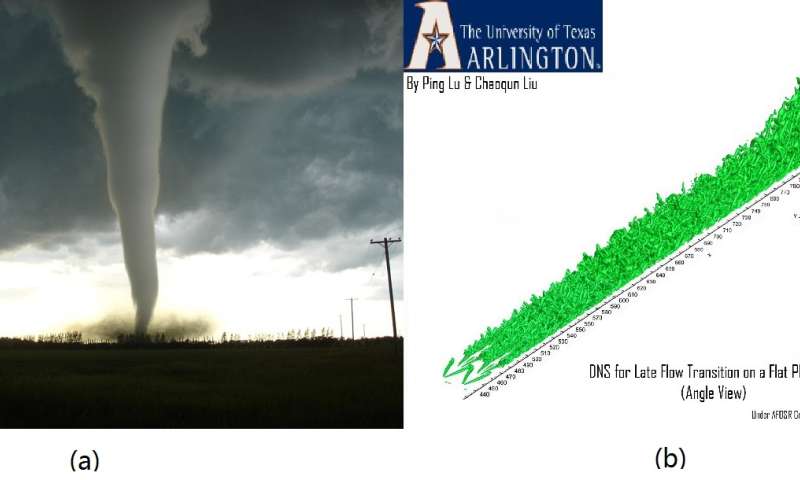A new vortex identification method for 3-D complex flow

Vortexes are physical phenomena found throughout nature, including tornados and air turbulence, which is a vortex buildup process (Figure 1). Investigators have realized that turbulence is not a purely stochastic process, but one with coherent vortical structures that play a decisive role in fluid dynamics and energy transport. Therefore, accurate visualization of vortices from a large amount of data obtained by experiments and numerical simulations becomes a key issue to solve turbulence, which is a century-long scientific problem. A new vortex identification method, which has been published in Science China: Physics, Mechanics & Astronomy, could advance turbulence-related research. The paper is titled "New omega vortex identification method."
The authors reviewed Helmholtz velocity decomposition and presented a new vortex identification method based on a deep understanding of the physics of vortex structure. This method was developed by Chaoqun Liu, a professor from the University of Texas at Arlington (UTA). Researchers including Yong Yang from UTA, Yiqian Wang from Nanjing University of Aeronautics and Astronautics in China, Zhiwei Duan from Tsinghua University in China and Zhengzhong Sun from London City University in UK have applied this new method to variety of complex 3-D flows with promising outcomes, proving the accuracy of the method.
The authors proposed a further decomposition of the vorticity to the vortical and non-vortical parts after Helmholtz velocity decomposition and some counterexamples like the Blasius solution, which has large vorticity but no vortex. They introduced a so-called to define and identify vortex. is a ratio of vorticity square over the sum of vorticity square and deformation square.
According to the ratio, vortex is defined when vorticity overtakes deformation or >0.5. The iso-surface of =0.52 is utilized to represent the vortex surface and further to visualize the vortex structure of the flow field. These researchers applied the method for 3 different cases including late boundary layer transition, supersonic micro vortex generator and roughness induced transition. Although the three cases have very different Mach number which means the compressibility affection are quite different, the iso-surface of =0.52 well represent the vortex structure without wild adjustment of threshold for all three cases. This is a unprecedented effort to give vortex a mathematical definition. All traditional vortex identification methods have a common critical weakness which is requirement of selection of a proper threshold. The threshold could be wildly changed case by case, time by time, and even area by area in same case.
Different thresholds will lead to different vortex structure and no one is able to know which threshold is appropriate and which vortex structure is correct. Being different from the traditional vortex identification methods, the method is quite universal and has no need to set up a threshold case by case. In addition, the method has other advantages which include being easy to perform, having clear physical meaning, and high capability to capture both strong and weak vortices. In general, people think vortex is "vorticity tube", but the method indicates that vortex is a region where vorticity overtakes deformation and vortex is not vorticity tube.
Traditional vortex identification can cause many misunderstandings. For example, people believe turbulence is caused by "vortex breakdown", but it is now understood that this is caused by wrong selection of vortex threshold. It is convinced Dr. Liu's vortex identification method would greatly stimulate research of physics for turbulence generation and complex 3-D flows, especially for vortices dominant flows. It is also believed that many scientists and engineers would apply this method for vortex identification and vortex structure visualization.
More information:
LIU Chaoqun, WANG Yiqian, YANG Yong & DUAN Zhiwei, New omega vortex identification method, Science China: Physics, Mechanics & Astronomy, 2016 DOI: 10.1007/s11433-016-0022-6
Provided by Science China Press